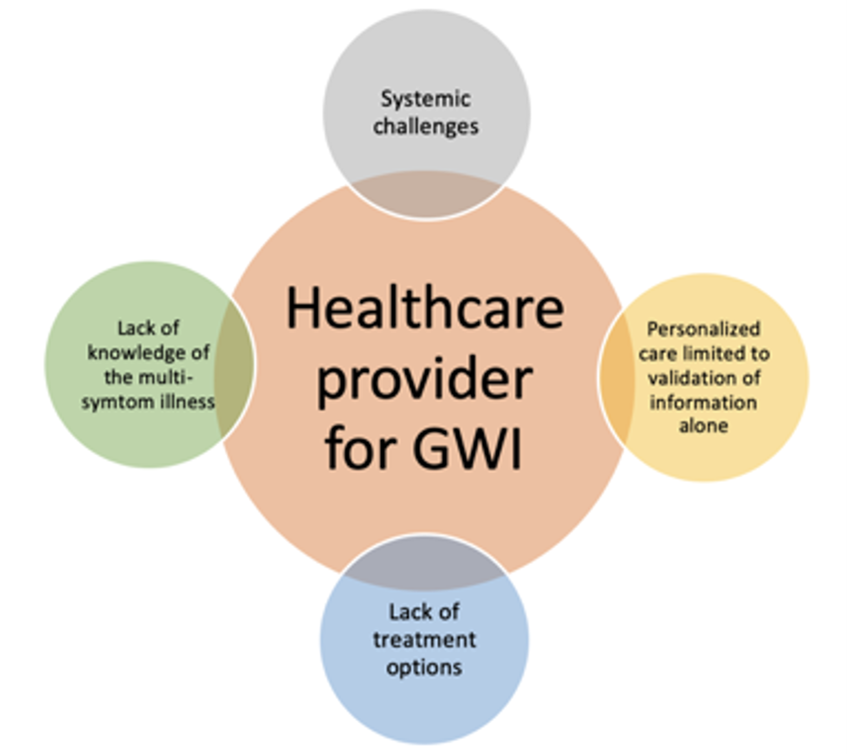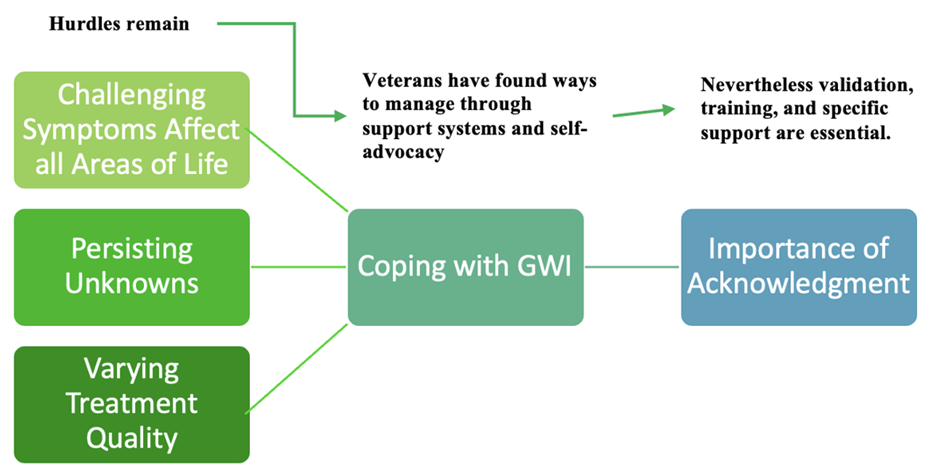Gulf War Illness: Background, History, Definitions, Exposures
This unit presents the background and history of Gulf War illness (GWI), as well as the definitions and exposures on site.
Background and History
The Gulf War occurred in two phases, Operation Desert Shield, from August 1990 to January 1991where troops were deployed to the Persian Gulf, and Desert Storm from January 1991 to February 1991, a 6-week air and naval bombardment followed by a brief ground assault. While Kuwait was liberated at the end of February, bombing continued for several weeks and explosives in hundreds of Kuwait’s oil wells produced gases and smoke for months.
Definitions
作为
Exposures
G
References
Fukuda, K., Nisenbaum, R., & Stewart, G. (1998). Chronic multisymptom illness affecting Air Force veterans of the Gulf War. JAMA, 280, 981–988.
Steele, L. (2000). Prevalence and patterns of Gulf War illness in Kansas veterans: Association of symptoms with characteristics of person, place, and time of military service. Am. J. Epidemiol., 152, 992–1002.
Gulf War Illness Symptoms and Psychosocial and Physiological Impact including Differences in Gender, Age and Ethnicity
This unit discusses the definitions, descriptions and effects of Gulf War Illness (GWI).
According to VA, service members and veterans started to report symptoms after their return from service in the Persian Gulf War. The symptoms of GWI vary widely and this makes it challenging for healthcare providers to recognize and treat it. Because of this variability, VA prefers not to use the term “Gulf War Illness,” and instead provides disability compensation benefits to veterans who served in Southwest Asia for illnesses that fall into the following three categories:
- Undiagnosed illnesses (established in 1994)
- Medically unexplained chronic multisymptom illnesses (established in 2001)
- Nine specific infectious diseases (established in 2010)
All three categories of Gulf War illnesses (undiagnosed illness, medically unexplained chronic multisymptom illness, and infectious diseases) are presumed to be related to a veteran’s service in the Gulf War.
The Institute of Medicine (now National Academy of Medicine) in 2013, defined CMI as the occurrence of a spectrum of chronic symptoms experienced for 6 months or longer in at least two of the following six categories- fatigue, mood and cognition, musculoskeletal, gastrointestinal, respiratory, and neurologic symptoms. Other psychological and physiological difficulties associated with Gulf War Illness include substance use, PTSD, insomnia, interpersonal difficulties, skin disorders, menstrual disorders, effects on autonomic and neuroendocrine systems, cognitive impairments amongst others. In Unit 2, we also summarize some recent research studies on adverse health consequences and diagnostic symptoms in gulf war veterans.
In terms of gender specific impact of Gulf War Illness, overall, there is a lack of studies for female gulf war veterans. Studies indicate higher rates of reproductive issues, miscarriages, and birth defects among veterans with GWI, and found that postwar conceptions were at increased risk for ectopic pregnancies and spontaneous abortions. Excess rates of women’s health problems in breast cysts, abnormal Pap smears, yeast infections, and bladder infections have been documented.
About 16 percent of the nearly 700,000 military personnel who served in the 1991 Gulf War were African American men and women. However, few studies have reported race-specific prevalence of Gulf War Illness and no studies have provided detailed race-specific information about symptoms.
The studies summarized in this unit demonstrate that more research needs to be conducted to fully grasp the multisymptomatic impact and mechanism of Gulf War Illness and how it affects specific gender and ethnic minorities similarly or differently.
Understanding the Illness Experiences: Health Care Provider Perspectives and Veteran Perspectives
This unit presents the findings of three studies about the health care provider perspectives and veteran perspectives regarding Gulf War Illness (GWI).
Study 1
In the first study, we interviewed 10 health care providers (7 females, 3 males; 8 white, 2 Asian; 3 physicians, 2 psychologists, 2 acupuncturists,1 social worker, 1 nurse, 1 medical sociologist, 1 pharmacologist) across the US about their experiences with veterans with GWI. We analyzed the data using a grounded theory method and created a grounded theory framework with four main categories: 1. Lack of knowledge of the multi-symptoms illness, 1. Lack of treatment options, 3. Personalized care limited to validation alone, 4. Systemic challenges.

Overall, the findings supported the notion that there are gaps in knowledge about GWI among healthcare providers, which leads to continued uncertainty about how to best treat GWI veterans. Given the challenges in care faced by veterans with GWI, further research including on systemic issues with lack of communication from the top down, and on difficulties in personalizing care is needed. The findings indicate that it is imperative that providers have access to educational materials on GWI.
Study 2
In another study, we examined veterans’ perspectives and lived experiences with GWI. Participants included 40 Gulf War veterans (32 males, 8 females, 28 white, 9 Black, 4 Latino, 3 American Indian, 1 Asian, and 1 multicultural) who were screened through CDC and Kansas Definitions of GWI. They were interviewed with a focus on the experience of their illness, healthcare received, supports and resources. At the end of the interview, they were given art materials to make an art collage response based on what was talked about and how they related to their GWI experience. We analyzed the data using a grounded theory method and created a grounded theory framework with five main categories: 1. Challenging symptoms affect all areas of life, 2. Persisting unknowns, 3. Varying treatment quality, 4. Coping with Gulf War Illness, and 5. Importance of acknowledgment.

Graphic Elicitations
In a third study, we compared the graphic elicitations of the veteran participants to the interview responses to learn what was specific about the art collage. Three main themes emerged that pinpointed what the art elicitation process could contribute: 1. Synthesis and confirmation of themes, 2. Salient aspects of living with GWI, and 3. Revealing previously unarticulated experiences.
The unique contributions of the collage process overall were to promote spontaneity and metaphorical thinking, uncover lived experiences, and allow for new affective responses.
Interventions and Treatments for Gulf War Illness
Research to test interventional approaches and identify standards of treatment for Gulf War Illness continues to remain in progress. Some of the resources that are available include:
- VA/DoD codified the best practices for the management of Gulf War Illness (GWI)
- War Related Illness and Injury Study Center (WRIISC), Department of Veteran Affairs has published a handout for healthcare providers for Gulf War Illness updated in 2018. This handout mentions pharmacological and non-pharmacological interventions such as CBT and exercise trials for active management of GWI symptoms.
- Other resources include systematic reviews and research published in special issues in journals on Gulf War Illness
In this unit, we summarize the intervention studies for Gulf War Illness that can largely be mapped on to categories of clinical and behavioral interventions, complementary and integrative treatments, diet and nutritional supplements, and other interventions and interventions including medications, simulations, etc.
One of the widely used Clinical and Behavioral Intervention include Cognitive behavioral therapy or CBT. Some researchers have examined the use of CBT for insomnia, problem-solving therapy, and telemedicine CBT with gulf war veterans. Mindfulness-based interventions have also been investigated as potential treatment methods for alleviating some of the symptoms associated with GWI. Complementary and integrative healthcare intervention continue to be utilized with US Gulf-War era veterans. Studies have examined the effect of exercise, acupuncture, acupressure, tai-chi, yoga, specific diets, herbal vitamins and nutritional supplements. Other interventions include the effect of CPAP - nasal continuous positive airway pressure, and studies including specific medications on the symptoms of Gulf War illness.
There is no one single treatment approach that is best and being used for veterans with Gulf War Illness. There is ongoing research about what might be helpful for the multisymptomatic illness with an increasing emphasis towards incorporating a multi-treatment approach.